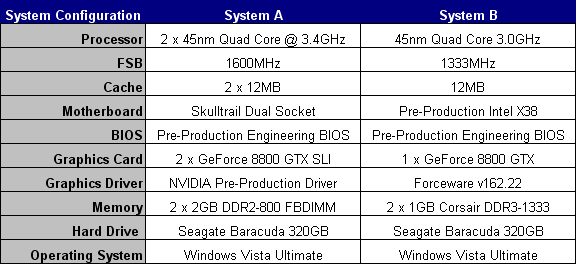Intel Skulltrail and Penryn Performance Preview
Intel Skulltrail and Penryn Performance
During a closed door session at IDF, we had a chance to get some hands on time with a few upcoming Intel platforms including Skulltrail, the octa-core platform Intel is targeting at enthusiasts. We also saw some dual-core 45nm desktop and mobile (Wolfdale) machines at work and even snapped off a few pics of a phase-change cooled, overclocked Skulltrail machine that was running at 4GHz.
Representatives from Intel wanted to get the point across that Wolfdale is going to be a very power friendly product and showed off a system running Windows Vista that idled at only 60w while sitting at the desktop.
They then moved down the line at to talk about a couple of identical Dell Latitude D830 notebooks. The machines were similar, except for the processors used – one had an as yet to be named 45nm dual-core mobile processor running at 2.8GHz, while the other was outfitted with a Core 2 Duo T7800 running at 2.6GHz. A few encoding benchmarks were run on the machines to show how much faster the 45nm processor was, thanks to its higher clock and SSE4 support. Benchmarks are below.
We also saw a trio of extreme machines. One was powered by a 3.0GHz Core 2 Extreme QX9650 (Yorkfield), another was a stock Skulltrail machine equipped with dual 3.4GHz quad-core processors, and the last system was a modded Skulltrail that was overclocked to 4GHz. The modded machine featured a pair of vapor phase-change coolers for the processors, liquid-cooled memory and GeForce 8800 GTX cards, all residing in a custom CoolerMaster case adorned with numerous skulls. While talking about the overclocked machine, reps from Intel mentioned that higher performance FBDIMMs are in the works as well, from a number of partners.
We watched a few benchmarks being run on the machines and have some results from the tests reported for you below. Please take note of the system configurations, as the desktop machines have different memory and graphics configurations.


As you can see, the Skulltrail machine is much more powerful than the QX9650, thanks to its SLI graphics, higher clocked processors (3.4GHz vs. 3.0GHz), memory, and eight execution cores.
Skulltrail will come at a cost, however. Because it’s based on a server platform, it requires FBDIMMs and its motherboard will be much more expensive than typical enthusiast class mobos. An exact price wasn’t discussed, but if you think of it as a high-end Intel-built server mobo and account for the additional NVIDIA SLI switches that enable SLI, you can get an idea as to how much just the mobo is going to cost. Think somewhere in the neighborhood of $500 - $600.
Update: We've got some information directly from NVIDIA about Skulltrail and its SLI support that we wanted to share with you all:
INTEL SKULLTRAIL PLATFORM FEATURES NVIDIA SLI TECHNOLOGY
-
NVIDIA nForce 100 Media and Communications Processors Provide An Exciting SLI-Ready Platform for Intel Customers
-
Intel demonstrated its new “Skulltrail” motherboard at this week’s Intel Developers Forum in San Francisco, CA. Skulltrail is a dual-socket motherboard that is targeted at ultra-high-end desktop enthusiasts and workstation customers.
-
The Skulltrail motherboard uses Intel's workstation “Stoakley” chipset designed for 2P CPU operation (1P configurations are not supported).
-
To enable NVIDIA SLI support, Intel has purchased NVIDIA nForce 100 SLI MCPs from NVIDIA.
-
The NVIDIA nForce 100 MCP converts a single x16 PCI Express Gen 1 bus into dual x16 PCI Express Gen 1 buses. This is how SLI is being supported on Skulltrail.
-
NVIDIA assisted Intel in the bring-up and testing of the Skulltrail motherboard which was publicly demonstrated at the Intel Developers Forum in San Francisco this week.
-
NVIDIA SLI technology is the world’s leading multi-GPU platform, allowing multiple NVIDIA GeForce graphics processing units (GPUs) to work together, resulting in scalable performance.
-
Intel has not licensed SLI technology from NVIDIA. Intel purchased NVIDIA nForce 100 MCPs to enable support for SLI.
-
Skulltrail is the only Intel motherboard which will feature NVIDIA SLI support. Intel is not using the NVIDIA nForce 100 MCP on any other chipsets, including X38.
-
For other 1P segments of the Intel market, NVIDIA has a wide variety of SLI products already available, including the leading nForce 680i SLI MCP for enthusiasts and gamers.
-
Skulltrail motherboards will only be available directly from Intel.


On the mobile side, we witnessed a couple of encoding benchmarks that showed the benefits of SSE4. The notebook equipped with the 45nm processor finished the tests significantly faster than the existing Core 2 Duo T7800.






